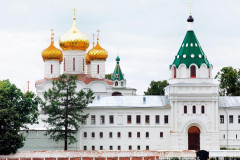Open-air Museum of Wooden Architecture in Kostroma
Description
Kostroma architectural-ethnographic and landscape Museum-reserve "Kostroma Sloboda" is one of the oldest open-air museums of Russia, located in the city of Kostroma.
Location
The main territory of the Museum-reserve is located on the South wall of the Ipatiev monastery, at the confluence of the Kostroma river with the Volga. Another exhibition area is on the side of the North wall of the Ipatiev monastery (at the entrance to the main monastery entrance): here is located the oldest monument of ecclesiastical wooden architecture of Central Russia — the Cathedral Church of the blessed virgin Mary (1552)
The history of creation
The establishment of the Kostroma Museum of wooden architecture (the original name) associated with the construction of the Volga dam of the Gorky hydroelectric station and the creation of the Gorky reservoir (1955-1957). In the post-war years (1946 — early 1950s) in Kostroma oblast it was sent several expeditions of the Academy of architecture of the USSR with the aim of identifying the most valuable monuments of Russian architecture. The first was the expedition under the leadership of S. L. Agafonov.
The creation of the Museum's collection began with transportation to Kostroma the wonderful monuments of wooden architecture of the beginning of the XVIII century — the Transfiguration Church in the village of Spas-Vezhi from flooded territories. They were installed in the New city of the Ipatiev monastery in 1955. After that the Cathedral Church of the blessed Virgin Mary from the village of Kholm (the Galich district of Kostroma region) was transported and placed at the walls of the Ipatiev monastery, and the Church of Mercy of the Savior from the village of Fominskoye, Kostroma district.
Farmhouses and farm buildings (baths, barns, mills) of XIX-XX centuries were also transported in addition to churches. The were also placed near the walls of the Ipatiev monastery.
Exhibits
The Cathedral Church Of The Blessed Virgin Mary
The monument was first described by the expedition of the Academy of architecture of the USSR in 1946 near the village of Kholm near the town of Galich (Kostroma region). The monument dates back to the year 1552. According to the legend, widespread in the environment of the Kholm residents, the Cathedral was built by two brothers — carpenters Carp and Papilla, which were supposed to have subsequently been buried under this temple. The members of the expedition headed by Agafonov found two burials, but they were in different parts of the basement (one burial under the altar, the latter in the refectory). In 1960-1962 the monument was moved to Kostroma and is mounted behind the river Kostroma in the North wall of the Ipatiev monastery.
Church Of Mercy Of Our Saviour
The Church of the village Fominskoe of Kostroma district dates back to the year 1712. It belongs to widespread type of Kletsky churches. Consists of four "klet" (parts): the altar, the quadrangle, the refectory, the porch (canopy). Octagonal bell tower cut into the roof of the anteroom. The gable roof of the temple is "canted", two coats of planks "with the rock" (between the upper and lower layers of wide planks laid sheets of birch bark), onion domes of the quadrangle and the bell tower covered with aspen shingles. The interior of the Church is a wonderful example of folk craftsmanship: it is made in the Canon of seventeenth-century benches with shaped legs and carved edges into the log along the walls; the choir, decorated with geometric carving, the front of the iconostasis installed at the North and South walls. Notice the floors of chopped timbers, casemate and portage Windows and solid front door with axes lock. Located on the main territory of the Museum-reserve (South of the Ipatiev monastery)
The Church Of Elijah The Prophet
Church in the village Upper Berezovka Soligalich district, Kostroma region. The exact date of construction is unknown. The researchers of the monument, based on the structural and stylistic features give the uncertain Dating of its building — the XVI—XVIII centuries. The upper floor was occupied by "summer" - an unheated church in honor of Elijah the Prophet. The Church has a rich interior. Of particular interest is the interior of the Church year, where preserved: the so-called "sky — arch, and covered with homespun canvas depicting scenes of the passion of Christ; a four-tier carved iconostasis; mounted on the walls of the quadrangle painted table, where in two rows were placed icons; carved canopy over the shroud in the Northwest corner of the quadrangle.
Heritage village
Along the scenic river Igumenka there are residential farmhouses and many outbuildings: mills, barns, baths, around 30 monuments of wooden architecture of Kostroma region and neighboring Nizhny Novgorod and Vologda regions. Thematic exhibitions are opened inside most of them.
Cultural events
The territory of Museum-reserve "Kostroma Sloboda" is also a platform for folk festivals in the traditions of pre-revolutionary Russia, folklore festivals, promotion and support of folk arts and crafts. The objects located on the territory of Museum-reserve, always popular with filmmakers: on the territory of Museum-reserve often work for film crews, taking both artistic and scientific-popular movies.

